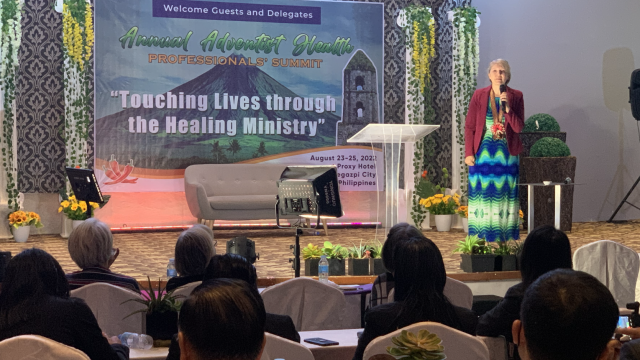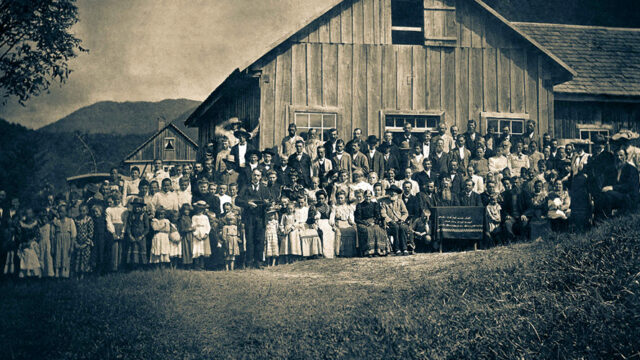Adventist identity and the presence of God

Who do men say that I, the Son of Man, am?” Jesus asked. “Some say John the Baptist, some Elijah, and others Jeremiah or one of the prophets,” His disciples replied.
“But who do you say that I am?” Jesus asked (Matt. 16:13-15).
On this question of Christ’s identity everything hinges—including my identity, your identity, and the identity of everyone else.
“You are the Christ, the Son of the living God,” Peter correctly answered (verse 16).
Jesus of Nazareth entered this world as a human son, born to an ordinary Galilean woman. If you passed Him on a dusty road, you might not have even noticed Him. Jesus seemed like an ordinary man, but He was far more. He was the divine Son of God—“the Word.” He “was God” and “He was in the beginning with God” (John 1:1, 2).
This same “Word became flesh and dwelt among us” (verse 14). Thus, He was called “Immanuel,” which means “God with us” (Matt. 1:23). Only through Him—truly God and truly man—could humanity be reconciled to divinity so that humans can live with God forevermore.1
But we are not yet with God in the way He originally intended—the way the first humans dwelled with God in Eden before sin, when God walked “in the garden in the cool of the day” (Gen. 3:8). The entrance of sin severely disrupted the fullness of God’s presence with us. Satan became the temporary “ruler of this world” (John 12:31; 14:30; 16:11), and evil, suffering, and death became part of all human experience.
But God responded with amazing grace, promising that a descendant of Eve’s would come and crush the serpent’s head (Gen. 3:15)—foretelling that Christ would endure the ultimate suffering to defeat Satan and eventually eliminate evil, so that God could be with us again in fullness, forevermore.
GOD’S PRESENCE IS CENTRAL TO ADVENTIST FAITH
Many identify God’s presence as Scripture’s central theme.2 Accordingly, God’s presence is central to Adventist theology and identity, embedded in our very name—Seventh-day Adventist. The “Adventist” part of our name identifies our faith in Christ’s second coming, after which “we shall always be with the Lord” (1 Thess. 4:17). The “Seventh-day” part emphasizes the Sabbath, the seventh day, set apart for worship and restful communion with God as a memorial of God’s works of creation (Ex. 20:11) and deliverance (Deut. 5:15).
In these and many other ways, Adventist faith is bound up with the hope of unbroken communion with God. Altogether, the name Seventh-day Adventist highlights God’s presence with us in “time” (the gift of the Sabbath) and the final restoration of God’s personal presence with us (the Second Coming).
Alongside these stands the sanctuary system, through which God makes a way to be with us despite the disruption brought by sin. The entire story of redemption revolves around God’s presence, with Christ’s works of atonement bringing about the ultimate fulfillment of God’s promises to be with His people.
Let us briefly take a closer look at these three pillars of Adventist faith and identity—the Sabbath, the sanctuary, and the Second Coming.
THE GIFT OF THE SABBATH
Some view Sabbath as a burden, but it is the opposite—a great gift of grace! The Sabbath is a gift of God’s presence; a day in which we can rest in His works so we do not have to work (the opposite of works-based religion). As Jacques Doukhan explains: “In obeying the fourth commandment, the believer does not negate the value of grace” but “through obedience to God’s law, the believer expresses faith in God’s grace.”3
The Sabbath is a sign that God saves His people—God sanctifies (makes holy) His people as His work of grace, in which believers can rest. As God proclaims in Ezekiel 20:12: “I also gave them My Sabbaths, to be a sign between them and Me, that they might know that I am the Lord who sanctifies them.”
The Sabbath thus stands as a sign of the identity of God’s people, those who belong to Him and are saved by Him. At the same time, the Sabbath rejects any attempts to locate our value or identity in our productivity or achievement, calling people to rest in what God has done and is doing.
The Sabbath is also a day of deliverance, remembering how God saved Israel from slavery in Egypt (see Deut. 5:15). Isaiah 58 further sets the Sabbath in the context of God’s concern for justice, calling God’s people to “release the bonds of wickedness, to undo the ropes of the yoke, and to let the oppressed go free, and break every yoke,” to share “bread with the hungry and bring the homeless poor into” our house, to clothe the naked and not hide ourselves from our brothers and sisters and their needs (Isa. 58:6, 7, NASB)4—the kinds of things Jesus was criticized for doing on the Sabbath (Matt. 12; John 5; cf. Luke 4:18, 19). Notably, in a chapter on the Sabbath in The Desire of Ages, Ellen White wrote: “Every false religion teaches its adherents to be careless of human needs, sufferings, and rights.”5
In this and other ways, the Sabbath stands as a sign of allegiance to Christ and His kingdom of unselfish love and justice over and against the powers of this world that follow the dragon, Satan (see Rev. 12-14). The Sabbath likewise stands as a temple in time; a day God sets aside for rest and relationship, to rejoice in the love of our Creator and Sustainer.
In contrast to our achievement-obsessed world, which fosters anxiety and burnout, the Sabbath offers us a time to celebrate God’s work for us instead of focusing on our works—to commune with Him, enjoying what He has made instead of chasing after what we might strive to make of ourselves, to rest in Him. In an age in which people are becoming more lonely, busy, anxious, and distracted, such sacred time is increasingly important.
Among other things, the Sabbath provides sacred time for undistracted relationship with God and others. What a gift! Christ invites you: “Come to Me, all you who labor and are heavy laden, and I will give you rest” (Matt. 11:28).
THE GOOD NEWS OF THE SANCTUARY
Alongside the Sabbath—a temple in time—stands the sanctuary. The earthly tabernacle and temples prefigured the heavenly sanctuary in which Christ intercedes for us as our High Priest (Heb. 8:1, 2; 9:11, 12), to reconcile us to God forevermore.
This is tremendously good news! Yet many do not understand just how good this news is!
When many think of the sanctuary, they think of judgment—and not in positive terms. On the surface this is understandable. Most of us do not like to be judged. But for those in need of deliverance, judgment is very good indeed—the Lamb’s way of unselfish love defeats and displaces the cruel and oppressive way of the dragon.
Imagine a man in a courtroom, waiting for a verdict. Everything depends on it. Will the verdict be good or bad? He cannot know for sure. He waits for what seems like eternity. Finally the verdict is in. Guilty on all charges. The perpetrator is ordered to pay full restitution.
Is the man distraught or overjoyed? That depends on whether the man is on trial or a victim of the one found guilty, desperately hoping for restitution.
In the latter scenario the man and his family are overjoyed. Justice has finally come. They’ll get back what was lost. Deliverance has come through judgment.
In Scripture judgment is a wonderful thing—bringing justice and deliverance for victims of evil. The faithful in Scripture thus cry out for God to bring judgment, not questioning why God brings judgment or trying to avoid it, but often wondering why God does not bring it more swiftly and decisively.
Through the sanctuary proceedings God will bring justice in the end. Through the sanctuary proceedings God vindicates His character and makes atonement for us, reconciling us to Himself, so that all who are willing to be saved can live with Him forever.
This wonderful news calls us to reflect on where we stand. Do we follow the dragon (Satan) and his ways or the Lamb’s way of unselfish love? Where is your allegiance? With whom do you identify?
Without Christ’s intercession for us, we would be condemned. But all judgment has been given to Christ (John 5:22), and He stands as the advocate of all who place their faith in Him (1 John 2:1)—all who ground their identity in Him as Savior and Lord. Without Him you cannot win. But with Him you cannot lose.
Christ’s ministry as our High Priest brings the reconciliation necessary for the full restoration of God’s personal presence with all creation. He works not only for your personal deliverance but to right all wrongs in the universe, to bring an everlasting kingdom of unselfish love. If you call on Him, He will rescue you. He is enough. As Ellen White wrote: “You will come up from the grave without anything, but if you have Jesus you will have everything. He is all that you will require to stand the test of the day of God, and is not this enough for you?”6
The dragon and his followers will finally be condemned, but all who repent of evil and embrace God’s unselfish love will be forgiven and cleansed (cf. 1 John 1:9). And the cry will go forth to God: “Righteous and true are Your ways, King of the nations!” And: “Your righteous acts have been revealed” (Rev. 15:3, 4, NASB).
In ways I cannot even begin to describe here, the sanctuary system displays the beautiful love and work of Christ for us and in us—to redeem and transform us so we can be with Him forever.
THE GREAT HOPE OF THE SECOND COMING
This brings us back to the great hope of the Second Coming. As noted earlier, the label “Adventist” identifies us as people eagerly awaiting and preparing for Christ’s second coming.
After Christ’s return, God will again “tabernacle” with us (Rev. 21:3). Then “God will wipe away every tear from their eyes; there shall be no more death, nor sorrow, nor crying. There shall be no more pain, for the former things have passed away” (verse 4).
In the meantime Adventists are tasked with proclaiming the three angels’ messages (Rev. 14:6-12) to help prepare the world for Christ’s soon return—preparing to be with God again in fullness. Among other things, the three angels’ messages highlight how the way of the dragon, who selfishly attempts to change God’s law, force worship, and dominate the world, is diametrically opposed to the way of the Lamb—the way of unselfish love.
At the Second Coming God’s personal presence with us will finally be fully restored. The story of Scripture is the story of God’s quest to restore the fullness of God’s presence with us as He originally intended. God desires to be with us so much that Christ became human—“God with us” in the flesh—and died for us.
In the end it will finally be the case that “the tabernacle of God is with men, and He will dwell with them, and they shall be His people. God Himself will be with them and be their God,” and there shall be no more evil, or suffering, or death—forevermore (Rev. 21:3, 4; cf. 1 Cor. 2:9).
The Adventist message is a marvelous theology of God’s presence—deeply interwoven with the story of redemption as the story of God with us. This is a message of great joy and hope and love—God with us again forever! We should not only present our faith and teach it as such wonderful news, but also live and love accordingly.
IDENTITY ROOTED IN CHRIST
As we await and prepare for Christ’s return, each of us must answer Christ’s question for ourselves: “Who do you say that I am?” (Matt. 16:15).
Who do you say that He is? The way you answer this question relates not only to His identity but to yours. Whether you recognize it or not, He is your Creator; He is the Lord over all and the only name by which we can be saved (Acts 4:12).
As God’s creature, made in God’s image, you are already of immeasurable value, and God invites you into ever deeper relationship with Him. If you believe in Christ, then you are in Christ by faith—an adopted child of God, with all the inheritance rights that brings (see Rom. 8:15-17). That is your ultimate identity.As Adventists, our faith is centered on God’s presence—our identity is bound up with waiting and preparing for Christ’s return, considering ourselves dead to sin, but alive in Christ (Rom. 6:11). Ultimately, then, our identity is rooted in Christ—who was and is and is to come, through whom everything was created, who gave His life for us, rose from the dead, even now ministers for us as our High Priest in the heavenly sanctuary, and will soon return to take home with Him all who trust in His name, to be with God forevermore. That is our identity—children of God, rooted in Christ, in hope. May we always remember who we are and live out our Adventist faith accordingly.
1 For more on this theme, see John C. Peckham, God With Us: An Introduction to Adventist Theology (Berrien Springs, Mich.: Andrews University Press, 2023).
2 See J. Scott Duvall and J. Daniel Hays, God’s Relational Presence: The Cohesive Center of Biblical Theology (Grand Rapids: Baker Academic, 2019).
3 Jacques Doukhan, “Loving the Sabbath as a Christian: A Seventh-day Adventist Perspective,” The Sabbath in Jewish and Christian Traditions, ed. Tamara Cohn Eskenazi, Daniel J. Harrington, and William H. Shea (New York: Crossroad, 1991), p. 155.
4 Scripture quotations marked NASB are from the New American Standard Bible, copyright © 1960, 1971, 1977, 1995, 2020 by The Lockman Foundation. All rights reserved.
5 Ellen G. White, The Desire of Ages (Mountain View, Calif.: Pacific Press Pub. Assn., 1898, 1940), p. 287.
6 Ellen G. White, Evangelism (Washington, D.C.: Review and Herald Pub. Assn., 1946), pp. 243, 244.








